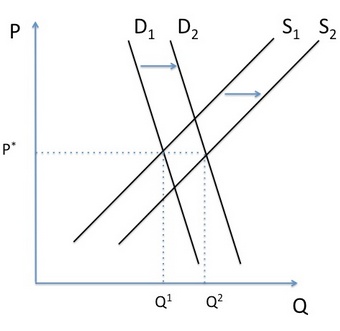Adam Ozimek has an interesting objection to my claim (here and here) that empirical work on the disemployment effect of the minimum wage contradicts empirical work on the wage effect of low-skilled immigration:
Bryan’s immigration example is missing an important point. When
immigrants move somewhere they don’t just increase labor supply, but
also increase demand for goods and services, and businesses in turn will
increase their labor demand. This is shown in the figure below, which
has the perfectly inelastic labor demand that the minimum wage results
imply but has not just labor supply but labor demand shifting out as a
result of immigration.
Adam’s figure:
Unless I’m seriously confused, Adam’s diagram doesn’t have perfectly inelastic labor demand. Perfectly inelastic labor demand is vertical. And given vertical labor demand, the effect of increased labor supply would be to reduce total labor income (lower P times constant Q means lower PQ). So workers’ demand for goods should fall, not rise.
In all fairness, though, Adam can probably fix his figure and restate his argument. What would I say then?
1. You could just as easily argue that the minimum wage increases workers’ income, leading to higher demand, offsetting the effect of the minimum wage. Advocates have made this argument before. So the severe tension between the minimum wage and immigration literatures persists.
2. More importantly, the magnitude of these effects almost has to be small. Low-skill workers only spend a tiny fraction of their income on goods produced by other low-skill workers. The same goes for every other narrow category of worker.
3. If these secondary effects really mattered much, supply-and-demand analysis would be pretty useless in the real world. A price floor on sugar could increase incomes in the sugar industry, increasing their demand for sugar, thereby eliminating the surplus caused by the price floor. Since supply-and-demand analysis is useful in the real world, we should presume that these stories are mere curiosities.
4. If we’re going to adjust for secondary effects, we need to adjust for all of the major secondary effects. The minimum wage and immigration also affect the income of employers and competing workers, so it’s not even clear whether total demand goes up or down.
Adam closes by pointing out that I’ve made an argument similar to his. Me:
When immigration increases, physical skills become more plentiful
relative to demand, but language skills become more scarce. Since most
jobs are a mix of physical and language skills, and people can change
jobs, immigration might actually increase native wages.
But Adam overlooks a key point: In this passage, I’m taking a macroeconomic perspective. The effect of the Mariel boatlift on Aggregate Demand can easily be large. But the total effect of the Mariel boatlift on demand for low-skilled labor in Miami? Probably trivial.


READER COMMENTS
Steve Sailer
Mar 19 2013 at 1:38am
“The effect of the Mariel boatlift on Aggregate Demand can easily be large. But the total effect of the Mariel boatlift on demand for low-skilled labor in Miami?”
David Card’s Mariel Boatlift example in which he compared wages in Miami following the May 1980 influx from Cuba to wages in four other cities over the next few years is a classic example of all else not being equal. It’s as bad as Steven Levitt forgetting about the crack years when making up his abortion-crime theory.
How was the economy of Miami different in the early 1980s than in other American cities? Did you ever see Miami Vice or Scarface? In a word, cocaine. Miami enjoyed a vast cocaine boom in the early 1980s.
Ceteris nonparibus.
http://www.vdare.com/articles/george-borjas-vs-david-cards-unworldly-philosophy
In general, economists don’t seem very good at remembering events that they read about in the newspapers, or at least not at remembering them when it’s time to do reality checks on theories.
Pemakin
Mar 19 2013 at 10:16am
The identification of physical and language skills in low skill jobs is a useful simplication of the complex notion of skills in any job. It also reveals the issue of interpretation of any single one of these studies to policy. Low skill jobs have a wide variety of physical/language mixes, so the impact of immigration should vary greatly depending on the types of low skill jobs present (never controlled for). Also, the language element is itself complex because it has a time dimension (language skills can easily improve) and a composition element (how bad really is it to be limited to Spanish in Miami, given the size of the the Latin community).
Richard A.
Mar 19 2013 at 12:52pm
Increasing the supply of labor in an economy will indeed increase the aggregate demand for labor. Nowadays in the US about 15% of workers are foreign born (the labor force was expanded by 15/85×100% with foreign workers–relative to natives, which equals 17.6%) and on average they are paid about 85% of native workers (ballpark figures on my part). The aggregate demand curve for labor shifts to the right by 0.176 x0.85% which equals 15%.
All sectors of the labor force enjoy this 15% rightward shift in demand. However, the supply of low wage workers that’s foreign born might be about 30% (guesstimate on my part). This means that the total supply curve that includes both natives and foreign workers shifts to the right by 30/70×100% which equals 43%. This looks like about a 28% (43%-15%) shift to the left of the demand curve for low wage workers.
Comments are closed.